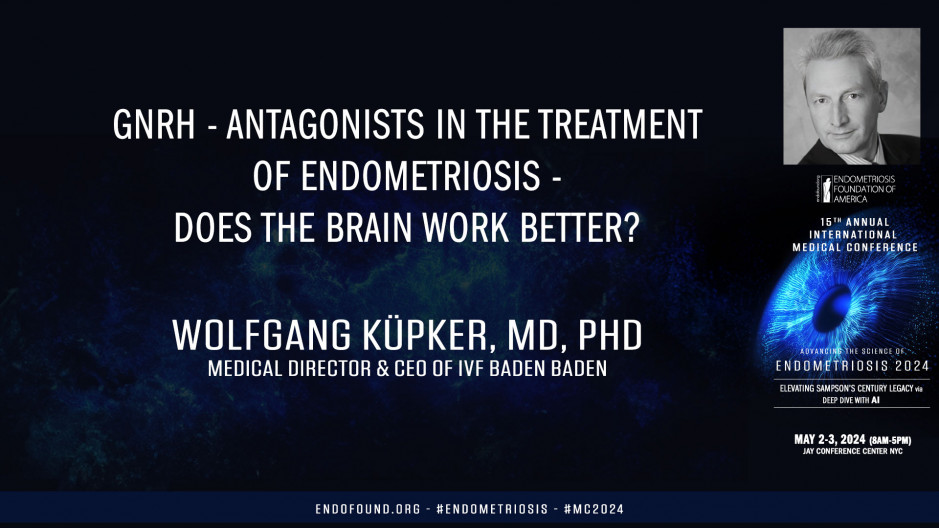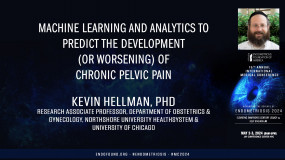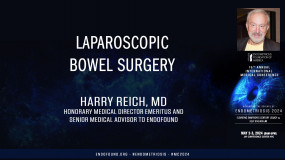International Medical Conference
Endometriosis 2024:
Elevating Sampson’s Century Legacy via
Deep Dive with AI
For the benefit of Endometriosis Foundation of America (EndoFound)
May 2-3, 2024 - JAY CENTER (Paris Room) - NYC
First of all, I'd like to thank the organizing committee of the Endo Foundation and particular Professor Seskin and Professor Martin for inviting me to this excellent meeting in New York City. Ladies and gentlemen, the audience In the morning session, we had some controversy about the question, if medication at all is needed in patients with endometriosis or surgery is the predominant approach. And now I come with a G and RH antagonists, ladies, gentlemen, within the next 15 minutes, it's mic. Does it work? It's okay. Okay. Within the next 15 minutes, it's not much time. I tried to take you on a fourth slide into endocrinology. Secondly, I have to convince you that the gene RH antagonist is a product that works on endometriosis and that potentially the brain works better. This is very provocative title of my lecture. So let's dive into endocrinology, but I have a disclosure. So as Dr. Shan told us in the morning, patients first, so we have to tailor a personalized medicine to our endometriosis patients. We all know these different pleiotropic appearances of endometriosis lesions. And of course, surgery is the predominant approach, not only for diagnosis, but for remove these lesions for a better life quality of our patients.
But we have to take into account that endometriosis is more than this. It is a chronic inflammatory,
Very complex autoimmune disease. And if you go into endocrinology, we know these are the key features of the endocrine, the impaired endocrine system, patients with endometriosis is the yeast bowel dominance, the elevated aromatase activity, the imbalance of the TRO gene receptors, alpha and beta. The progestin receptor resistant was mentioned before and in immunological disbalance. So what do our big societies recommend to do if medication is needed? Oral contraceptive, progestins and gene agonist. So most likely used are oral contraceptive or the progess. What's going on with the progess? So I start with progesterone, which is something different, and to go directly into the nervous system. And the brain progesterone exhibit with very interesting, in a very interesting manner, it leads to relaxation ans learning enhancement, improved cognitive functions, pain relief. So that means an not getting effects because of what? Because progestin, and this is the naif progesterone is converted into other pregna, and this is important.
So this allopregnanolone activates the G receptor, ends up in an elevation of the neurotransmitter activity and elevates this serum level all also progestin Synthes could be shown and confirmed in the center video cells and seems to be responsible for rejection of the me in sheath. But this is true for TIF progesterone and not for the most of the progestins. We apply to our patients. So we can encounter a lot of side effects. We can read it a bloating break, the bleeding breast discomfort, depression and dizziness and so on, headaches, irregular bleeding, moodiness, and so on and so on and so on. So the question is, is that a therapeutic success or not?
So we get our patients rid of this. So-called brain fog to go on with the scope of my lectures and releasing hormone was firstly characterized behind r Shelly from New Orleans, and he got the Nova price on that. And Gian Ridge acts in a very specific manner in the puls in this, the frequency and the puls ity was described by Ernest Nobel and in the eighties from the Department of Physiology in Pittsburgh is still working. I met him a couple of weeks ago. So what is all about the gene R gene errors receptor system? So it's a regulator of the HBO axis, and there's a vast distribution in fer organs and tissues and also in the center nervous system.
GNRH guides. Reproduction is responsible for the HCO axis and for the onset of the cycle at the end of fertility capacity, but also it has an impact on the brain and the nerves. That means neuroprotection, neurogenesis, cognition, sexual behavior, and aging. Very interesting. So what do we have? We have the G and agonists and the antagonists both tend spine and Shelly from gene, but the G average had turned out not to be so very efficient and beneficial because we have the flare up Phin. We have a company down relation desensitation of the receptors leading to a long-acting hypogonadism.
Much more elegant is the mode of action of an antagonist. A classical competitive receptor blockage gives us the opportunity to work or to apply this antagonist dose pattern for what? Because we want to meet the So-called therapeutic window in cases of endometriosis means the wellbeing of patients so that we have a basal isol secretion on the one hand, better bone density or no effect on the bone density. And on the other hand, endometrial lesion should not compress and should lead to an atrophy of endometrioid lesion. And this is possible with Israel concentration of approximately 40 50 picogram per mile. So our group could confirm this therapeutic window using in g and error. It's very, very long ago and nobody believed us, but nevertheless. So what we did, we applied relics once a week subcutaneously and we could achieve this oscillation around 50 picograms per mil.
And these were the effects of the integrous pain reduction. Not hot flushes. No hot flushes. Like before using the agonist, we had a sufficient steroid secretion, no at back was needed. The bone ization was steep, stable and we could confirm the atrophy of lesions. And now more than 50 years later, we have the oral antagonist, a real interesting product and could be confirmed that the antagonist works as we want it for our patients in pain patients with endometriosis and is a very, very nice paper from Taylor from the Yale group using ics, the first oral gene H antagonist. And he also could confirm the dose dependent manner. So the higher rate concentration of the antagonist, the lower the estradiol secretion.
Now I will come to the clue of my lecture. So what is the antagonist? What is gene RH itself going to the nerves and to the brain? And there seems to be a punitive central impact concerning mood, memory and sex drive, which is very important, especially for our endometriosis patients and the gn, RH and the antagonist exhibits action on the hippocampus, the amygdala, and the tus and the gray matter. So the hippocampus is explicitly important for the memory function. So indeed in the brain we have troga receptors, we have GNH receptors, and under the pulsatile secretion of gnh, a local estrodiol protection is going on in the brain supported by a sufficient concentration of AL from the periphery. So this is needed that the local AL production in the brain takes place. There are quite interesting papers from basic research on the one hand from 2016 by Nelson and coworkers. They could show us indeed that the circulating TDI regular brain variety started via actions of the gian A receptors to impact manner in over these rats. The same could be shown in the paper from 2020 and Mai and Berg, that the Gian eridge itself as protective effects against amyloid induced cognitive decline. So the secretion of GnRH is of importance.
Shelly himself could show this in a nicely engineered mouse model that relics blocks beta amid 25 35 with an anti-depression like action anxi lenses and a memory consultation. And what is happening when we use the GM antagonist, the clue of all of this, that on the one hand we give the antagonist in a dose dependen manner, we have a specific half lifetime and not all receptors abound. That means we have a sustained GnRH action, especially in the brain. The simple doctor like me that are to say a clinician, what a clinician can learn from this. First using the G guarantees pain reduction. And this is of foremost importance as we know that oral contraceptive and progestins, they are effective, but they do have side effects. The antagonist is selective and effective and has sustained al secretion while it sustained gage positivity, which is of utmost importance. So given the gage antagonist could give us a kind of concert of a local estradal secretion in the brain together with GM RH itself. So that means for me that the antagonist offers a balance harmonic treatment.
So what can be expected? Pain relief. Of course this is of importance. No mood changes, improve cognition, better memories, and the better sex style. How can we confirm this? So I think it could be a very good opportunity to measure the neuroplasticity in the brain function using functional MRI brain imaging. So that should be done. And of course, ask our patients, talk to them. How is the life quality under the GNH and integrase? Our group treated about 120 patients and we had quite good success except one or two patients where this doesn't work. So thank you very much for your intention and your patience. This is it.










